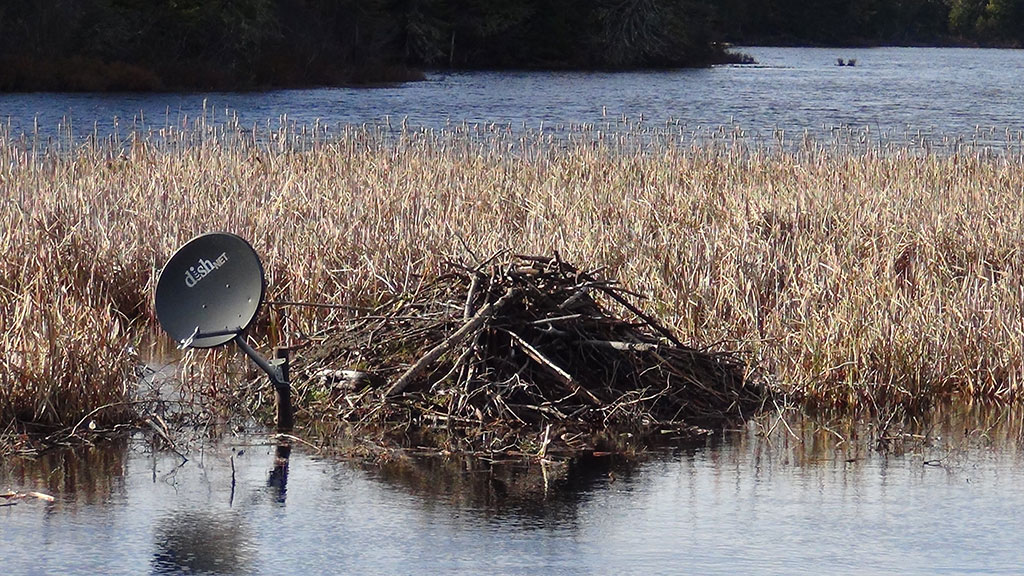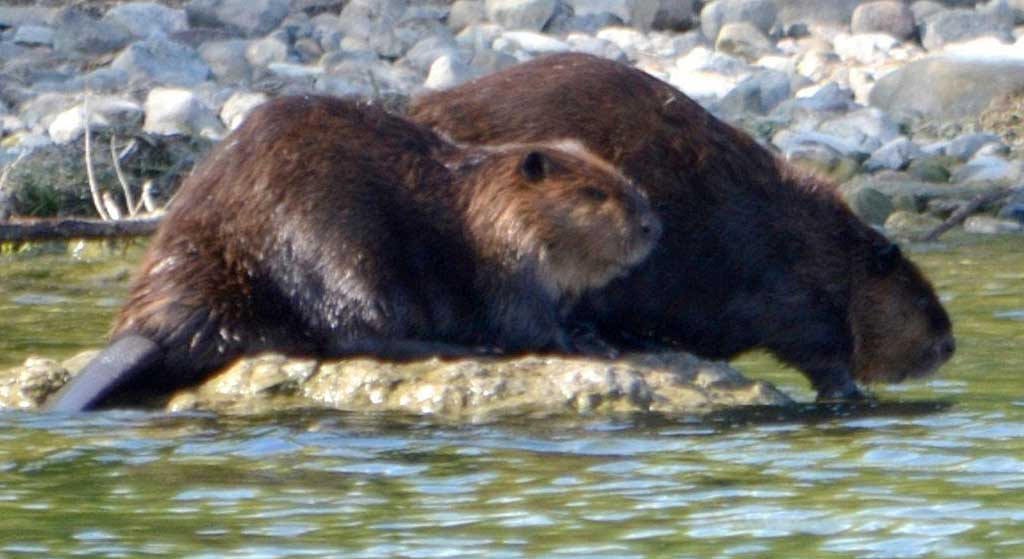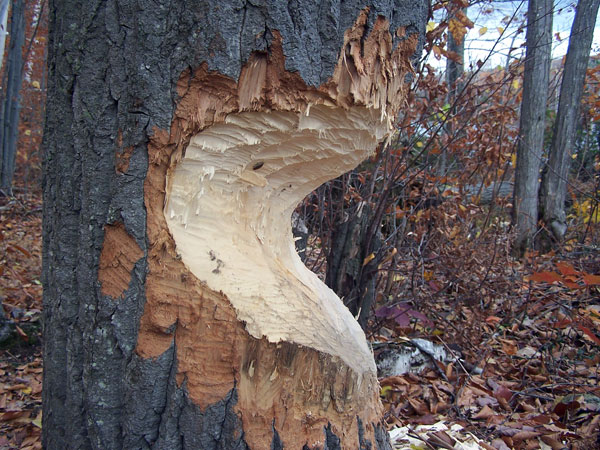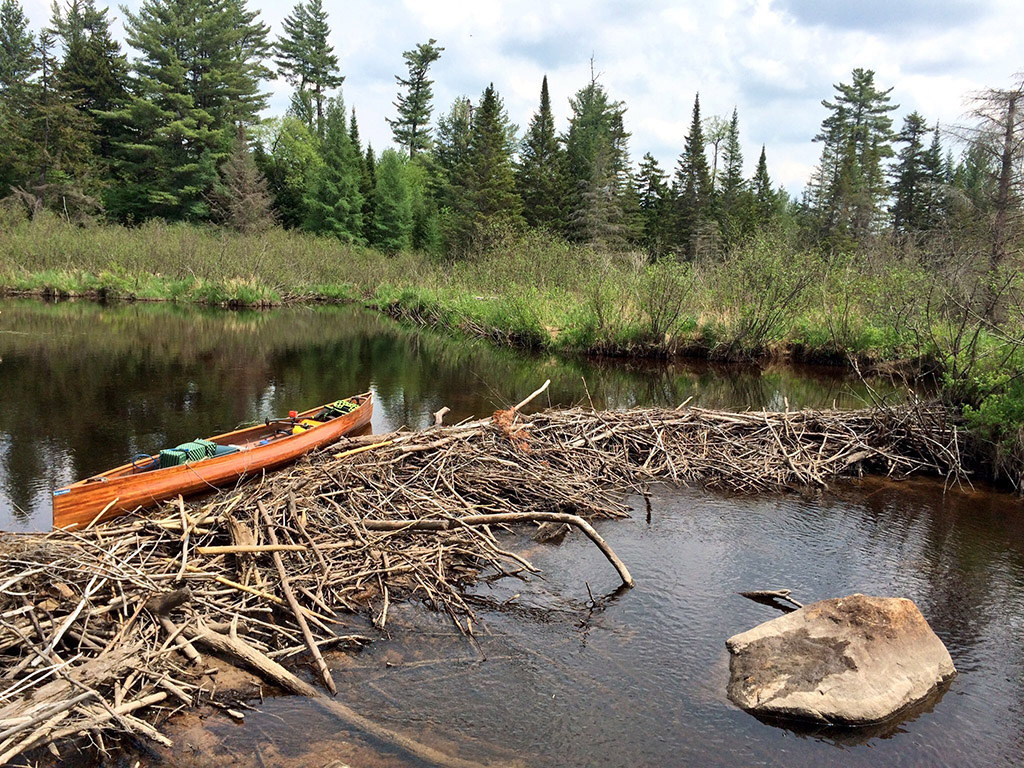Beavers: the “Little People” next door
Among the myriad blessings in my life are the neighbors. In the decade I’ve lived at my current address they have come through with everything from a jump-start on a cold morning to a cup of sugar in the midst of pie-making. They’ve even delivered and stacked firewood when I was ill for an extended time.
A couple of years ago I became concerned when a new family built a house next door, just threw it together without so much as a building permit or a civil “hello.” They were hard-workers, to be sure, and could fell timber like there was no tomorrow, but were very stand-offish, and I began to eye them with suspicion. After it was brought to my attention they were beavers, we got along much better.

A well-appointed beaver lodge at Deer River Flow in Duane. Photo: Pamela Merritt

Sunning beavers. Archive Photo of the Day: Pam Monacelli, Massena, NY
Once near extinction, beavers staged a big comeback
The North American beaver (Castor canadensis) has superior fur than does the species (Castor fiber) found in Europe and Asia. But it doesn’t always pay to be the best. Once nearly extirpated from this continent to satisfy demand for its castor—gooey stuff from its anal glands prized for use in perfumes and medicines—and its lustrous fur, our native beaver has made a remarkable comeback in the past 50 years.
This population rebound is great for improved water quality and groundwater storage, healthier fisheries, habitat diversification, and more migratory waterfowl. It is not such good news when beaver engineering clashes with human engineering, as happened one morning when I found that a stream, usually directed under my dirt road, was suddenly flowing over it and washing away the roadbed at quite a clip.
Sharing an enthusiasm for construction engineering
Humans and beavers alter their environment more drastically and much faster than other animals can. The difference is that beavers are not generally subject to building codes or taxes for their lodges, or required to file environmental impact statements for their dams. While many of our dams are for hydro power, some are for safety—flood control downstream. Beavers also construct dams for safety, but in a different sense.

At up to six feet and 200 pounds, the extinct ice age giant beaver (Castoroides) would not be classed as “Little People.” Painting: Charles R. Knight, public domain
At home in the water but awkward on land, they are more vulnerable to predation by coyotes, fishers and wolves when in “dry dock.” This is why they landscape with water, which is beaver feng shui (mostly shui). In addition to building dams to create ponds, they excavate canals which extend their reach beyond the shoreline.
Beavers are sort of like ducks in the back, but raccoons up front. They have webbed hind feet for swimming, but agile forepaws for making mud pies (they don’t move mud with their tails). Other aquatic adaptations include being able to hold their breath for 15 minutes, and having a pair of inner lips behind their teeth so they can chew underwater. They also have a set of transparent inner eyelids which act like goggles, suggesting that prehistoric water may have been chlorinated on a regular basis.
On average, beavers measure about 3.5 feet in length, including an 8 to 12-inch tail, and weigh roughly 45 pounds, though they have been known to exceed 100. This makes them the second-largest rodent in the world after the capybara, and the biggest in North America. If animals of this size are building dams that range from a few yards across to more than 2,700 feet long, imagine what it was like in the Pleistocene with Castoroides , giant six-foot-long beavers that weighed 200 pounds or more. It must have been tough to be a nuisance wildlife control officer back then.

There’s evidence of “bark eaters” (beavers) along the shore of 13th lake in North River. Archive Photo of the Day: Mary Abramson
Who needs a chain saw?
I often marveled at the way beavers could chew through a 12” hardwood tree overnight. Turns out they have carbide-tipped teeth. This is true. Somewhat. The enamel in the front of their incisors is reinforced with high concentrations of iron, so the back always wears more, giving the tooth a perfect chisel shape. They gnaw wood to fell trees and to get building material, but bark is their main food.
Besides eating bark, beavers munch on twigs, buds and leaves of various trees; favorites are birch, aspen, willow, and maple. Because they are active all winter, even under thick ice (the entrance to their lodge is kept clear), they sock away loads of tasty tree parts underwater in the bottom sediments. Pond-lily tubers are relished, though I don’t know where they get the relish. Also, they will roll up lily pads like cigars and eat them, presumably because they found the green cheroots difficult to light.
The nicest “Little People” you’d want to meet. . .
Exemplars of family values, beavers are monogamous for life, which translates to maybe a 10-year marriage between first mating at 2-3 years and death at the ripe age of 10-15. This is better than the 8.2-year average length of marriage in the U.S. And both male and female beavers help raise their offspring.
Social bonds are strong, with three generations often living together. Older siblings frequently pitch in to groom or babysit the young kits. Beavers of all ages, especially yearlings and kits, have been observed engaging in play. This is one of the reasons many Native American peoples refer to beavers as “Little People,” and hold them in high esteem.

Paddling break at a beaver dam on the Oswegatchie River upstream of High Falls. Archive Photo of the Day: Dwight Stevenson, Canton, NY
. . . but even nice neighbors can be annoying
Apparently, the sound of running water is their cue to check for breaches in dams. Researchers played a recording of a babbling brook next to a beaver lodge, and most of the inhabitants went right out on leak patrol. I imagine the rest of them had to excuse themselves to go empty their bladders.
Even though they may have the moral high ground when it comes to social issues, beavers can be annoying neighbors. I had to protect the trunks of young fruit trees from beaver teeth, and “adjust” their dam so the yard did not flood. Solutions can be simple, like an “over-under” pipe that lets them build the dam as tall as they want while leaving the water level where you want it.
Paul Hetzler is a horticulture and natural resources educator with Cornell Cooperative Extension of St. Lawrence County.







